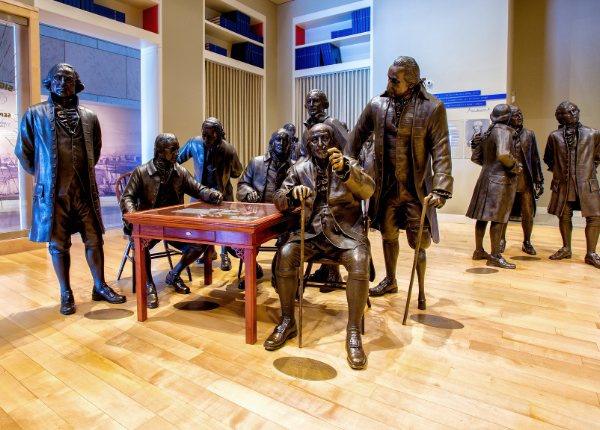
Constitution Day Resources
Lyle Denniston, the National Constitution Center’s adviser on constitutional literacy, examines the rising pressure that state legislatures are putting on state courts through budget restrictions and other measures.
THE STATEMENT AT ISSUE:
“In multiple states, 2015 already has become a banner year for court-bashing by elected politicians. Are state legislatures breaking all records for attempts to rig our courts? The results are still coming in, yet it appears to be a banner year for elected politicians trying both new and well-established ways to bully, politicize or pack impartial courts. What’s alarming is that they are succeeding. … [In Kansas,] an axe is hanging over funding of the entire state court system because elected officials chose to make political pawns of state courts.”
– Excerpt from a commentary in the press on September 8 by Liz Seaton, interim executive director of Justice at Stake, an advocacy organization that seeks to protect the independence of state courts across the nation.
WE CHECKED THE CONSTITUTION, AND…
When a new national government was being framed for America in the late 18th Century, the architects of the Constitution were determined to have a balanced government—one in which government authority was divided, to prevent the kind of concentration of power that was typical of the much-resented English monarchy. Liberty would be protected, the founding generation’s leaders believed, if a system of “checks and balances” could emerge from a division, or separation, of governing authority.
A balanced government, James Madison argued, was necessary to preserve a republican form of government—that is, a government in which ultimate power resided with the people themselves, acting through representatives who would be entrusted to run the government day to day in the interests of all of the people.
Madison and his peers believed that this balance was not only a good thing for the new national government, but also for the state governments that already existed and would continue in the new governing order. In fact, the founders wrote into the Constitution’s Article IV a promise that the new national government would “guarantee to every state in this Union a republican form of government.”
It has never been very clear just what was intended by this promise, and how it would be enforced. The Supreme Court over the ensuing decades would pay little attention to it, except to make it clear that fulfilling the promise would have to be left to the political branches, not to the courts.
Even so, that guarantee remains in the Constitution, and represents an abiding aspiration that state governments should not stray from the republican ideal, or from the basic commitment to balanced government—the separation of powers—that is believed to be so essential to maintaining that ideal.
That aspiration is being challenged these days, however, by the actions of a growing number of state legislatures to rein in what some lawmakers apparently believe are courts that exercise too much power and are too resistant to what legislators want from them.
A quite extreme example of that type of challenge has been unfolding in the state of Kansas over the past year or so. The state’s legislature decided that it wanted to take away from the state’s Supreme Court the power to pick chief judges to lead each of the judicial districts for the lower state courts. Instead, the legislature ordered that this selection be done by the lower court judges themselves.
But, sensing that the state courts might strike down that measure as a form of legislative interference in judicial functions, the legislature followed up with a second measure, the bill to provide funding for all of the state courts for a two-year period. That legislation provided that, if the courts were to rule that the rearrangement of the judicial selection power violated the state constitution, all of that funding for the courts would be “null and void.”
State judges immediately saw the challenge to the state Supreme Court’s authority as a violation of separation-of-powers doctrine, and so one of them sued in state court. In a ruling in early September, a trial judge agreed that the stripping of the power of the state Supreme Court was a violation of the separation-of-powers doctrine under the Kansas constitution. That decision did not deal directly with the fund-cutoff measure, but the judge, realizing that his ruling would trigger that cutoff, put it on hold so that an appeal could be pursued with court funding still intact, at least temporarily.
Four state judges then filed a new lawsuit, directly contesting the validity of the fund cutoff as a separate violation of the state constitution. They claimed that the measure violates the state judges’ right under the state constitution to make rulings without being intimidated by the legislature, and also violates their right to due process. That new lawsuit remains pending in the state court, while the judge-selection issue moves up to the state Supreme Court.
There is no doubt, of course, that state legislatures do have the power, under their state constitutions, to pass budget legislation. But Kansas’s constitution—and it is typical in this respect—does require that the legislature provide continued funding to operate the state court system. But, when the legislature uses its budget powers in a way that definitely seems to be controlling how judges rule on legal questions, that stirs up the separation-of-powers controversy to a pitched level.
The drama in Kansas has now mushroomed into a fundamental test of the nature of state government, at least when two of the branches are so at odds that a constitutional crisis develops. The institutions of Kansas government will have to work this out, because there seems no way for either side to turn to the national government for support—even though the guarantee of a republican form of government remains in the Constitution and thus is still a reminder that America as a whole is not indifferent to what happens in Kansas, or any other state where the republican ideal comes under siege.